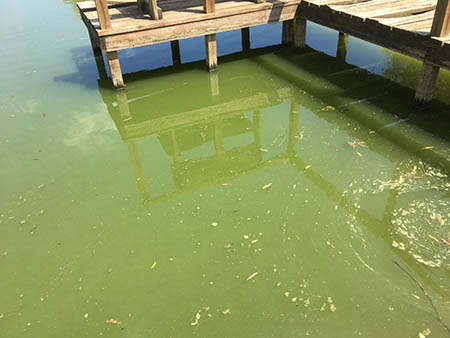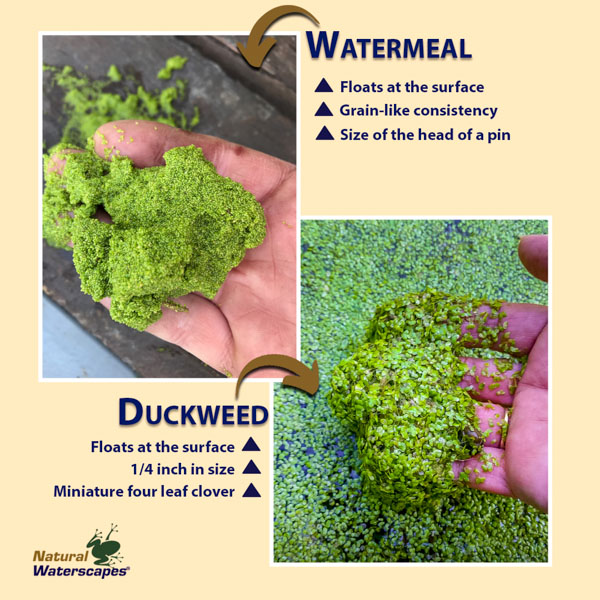Plagued with Green Pond Scum
Green pond, pond scum, pond moss, and algae scum are commonly used terms to describe a grimy looking pond. Treating green scum can vary based on WHAT the scum really is.
Green pond, pond scum, pond moss, and algae scum are commonly used terms to describe a grimy-looking pond. Treating green scum can vary based on WHAT the scum really is.
What is pond scum?
Green pond scum can be any number of aquatic plants, algae, or even pollen that collects on the water surface. Some types of algae are single-cell organisms that float in the pond water. Others grow on the pond bottom before detaching and floating to the surface of the water. Tiny pond plants such as duckweed and watermeal multiply so quickly that it can seem that the surface of the pond has turned green in just days.
How can Pond Scum be Identified?
Identifying pond scum or algae is crucial for effectively managing the health of a pond. There are a few key characteristics that can help in identifying pond scum:
1. Slimy Texture: Many types of algae have a slimy texture. By performing a touch test, if a clump of pond scum, vegetation, or rock surface feels slimy, it is likely to be algae.
2. Matting Strands: Unlike plant stems, the strands of filamentous algae can mat and stick together, resembling hair. If you notice strands that clump together in this manner, it is an indication of filamentous algae.
3. Gritty Texture: Another possibility is that you may come across a rootless aquatic plant called watermeal. Watermeal appears as tiny grains with a gritty texture. It can be mistaken for algae from a distance.
By considering these characteristics, you will be better equipped to identify pond scum or algae in a pond.
Green Algae
There are a number of forms of algae that fall under these broad descriptions of scummy and green. Filamentous algae, also known as string algae, begins its life at the bottom of the pond, and then floats to the surface in large mats that can vary in color from bright green, dark green, to brown.
Planktonic algae, also known as green water algae appears to turn the water pea soup green. The green water color is actually suspended planktonic algae particles in the pond water. Algae grows when excessive nutrients impact a pond's water quality. Too much Nitrogen and Phosphorus provide the essential fuel for algae blooms to take over a pond. Nutrient management and aquatic algaecides are effective treatments.
Watermeal
Watermeal are very fine floating weeds often smaller than a grain of rice can quickly cover a pond. An outbreak of watermeal is unsightly and can also cause reduced oxygen concentrations in the pond.
Duckweed
This tiny plant multiplies at an incredible rate. Just a few plants can overtake a pond in less than a week. Duckweed has 2 small leaves with root that floats in the water to absorb nutrients. The plants split to produce child plants so a population can grow exponentially. Duckweed and watermeal are found together in some areas.
Treatments for all of the above described "green pond scum" use varying management techniques.



Pond Scum Treatments
Treatments for all of the above described "green pond scum" vary by the cause.
Filamentous algae (string algae)
Kill existing floating algae mats with Cutrine Plus liquid algaecide. Spray directly on algae. Since string algae forms on the pond bottom, it is important to use treatments that persist at the bottom. For submerged algae control, treat with Cutrine Granular Algaecide which controls algae growth for up to 5 weeks.
After chemical treatment add Pond Dye to limit regrowth. Adding beneficial bacteria from Pond Cleanse and Muck Remover helps to reduce the growth rate of algae by digesting the nutrients essential for algae growth. Phosphate Eliminator works well to bind excess phosphate that feeds algae growth as well.
Planktonic algae (green water)
The safest solution for managing green water is to treat with Pond Cleanse and Phosphate Eliminator every two weeks. This may take multiple treatments to begin noticing results. This algae control technique is both one of the most natural pond algae controls and also balances the pond and lake water quality for a healthier ecosystem.
Duckweed & watermeal
For ponds with little to no outflow use Propeller aquatic herbicide. For ponds with moderate flow, use Duckweed Destroyer Pack. This can be used to treat the entire pond or spot treat as growth begins. Because Duckweed and Watermeal reproduce so quickly, it is often necessary to add a follow-up treatment within a week of the initial treatment to kill any remaining weeds.
What if you have a combination of string algae and duckweed or watermeal? The Duckweed Destroyer Pack effectively kills string algae as well as the floating weeds.
Pollen Film
One of the best ways to prevent pollen from creating a scum film on the surface of a pond is to install aeration. Moving water from the aeration system (either a bottom aerator or surface fountain) makes it difficult for pollen to accumulate on the pond surface. There are many other benefits from pond aeration that make the investment worthwhile for most pond owners.
How does pond scum impact the pond ecosystem and wildlife?
Pond scum, formed as a result of eutrophication, has a significant impact on the ecosystem and wildlife in ponds. Eutrophication, which is caused by an excess of nutrients in the water, disrupts the natural balance of the aquatic ecosystem. When there is an overabundance of nutrients, such as nitrogen and phosphorus, on the pond floor, algae thrive and reproduce rapidly.
This excessive growth of algae, commonly referred to as an algae bloom, poses a threat to the survival of the pond ecosystem. Algae grow and multiply at a rate that surpasses the control mechanisms in the ecosystem. As a result, the natural balance of the pond is disrupted, leading to detrimental consequences.
As the algae and pond scum accumulate and decompose, the process consumes a significant amount of oxygen in the water. This depletion of oxygen levels is detrimental to oxygen-dependent aquatic wildlife, such as fish, insects, and other organisms. The reduced oxygen levels can lead to suffocation and death of these species, impacting the overall biodiversity and health of the pond ecosystem.
Furthermore, certain types of pond scum, such as cyanobacteria, release toxic chemicals into the water. These toxins can have adverse effects on aquatic wildlife, disrupting their physiological processes and overall health. Additionally, the release of these toxic compounds can further impact the pH balance of the pond, making it even more challenging for wildlife to survive.
If eutrophication and algae blooms remain unchecked, they can ultimately render a pond unusable, lifeless, and toxic. The excessive growth of algae and the subsequent pond scum disrupts the natural dynamics of the pond ecosystem, leading to devastating consequences for wildlife and the overall health of the pond.
